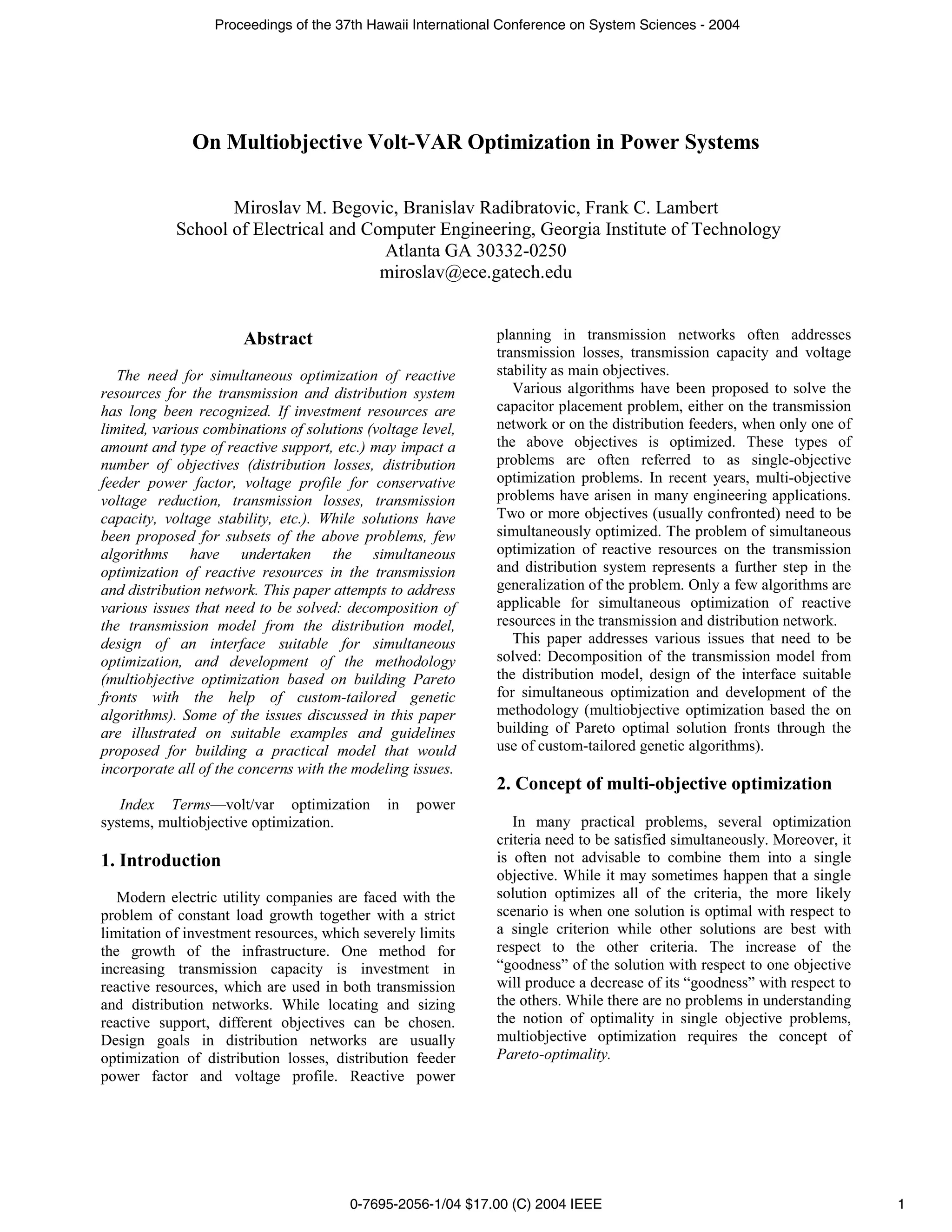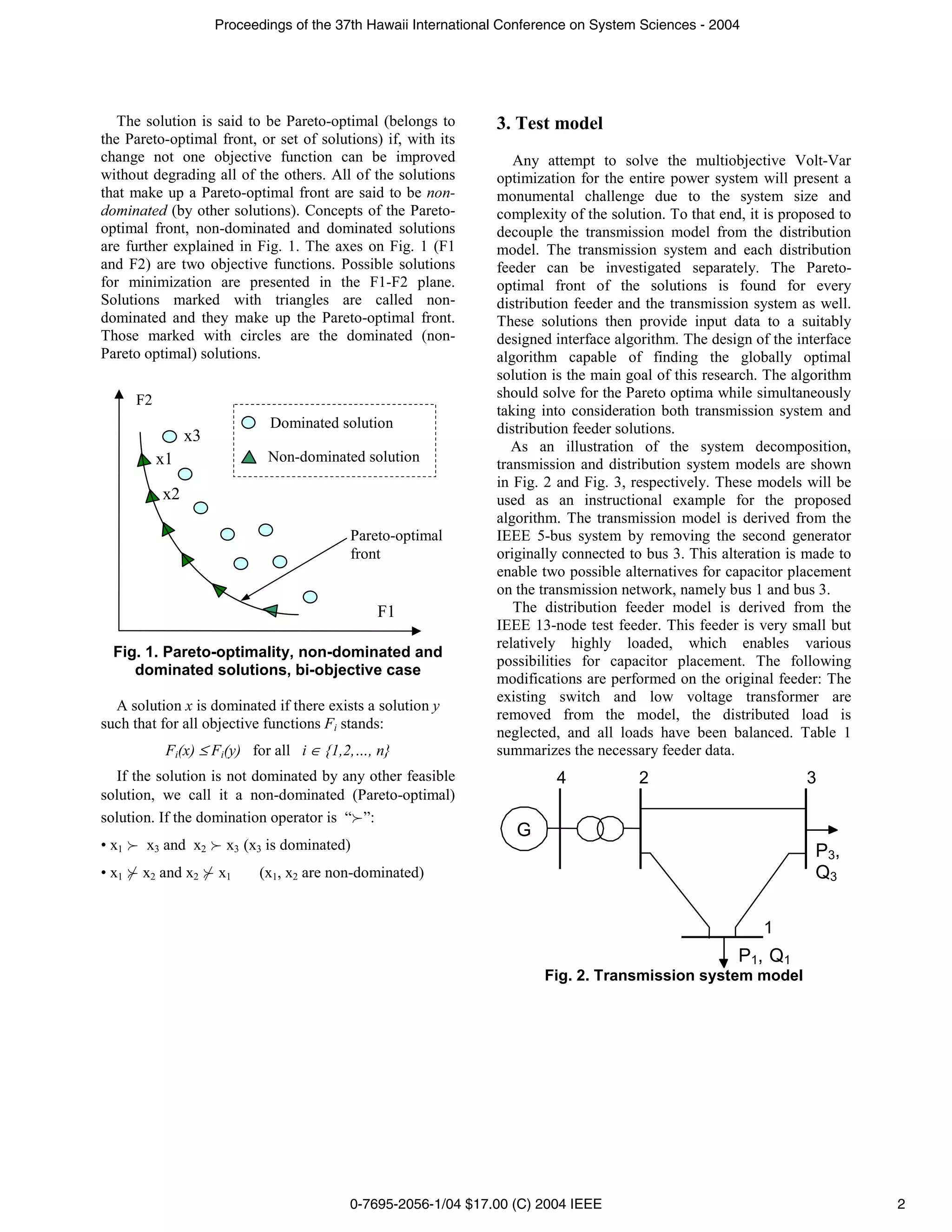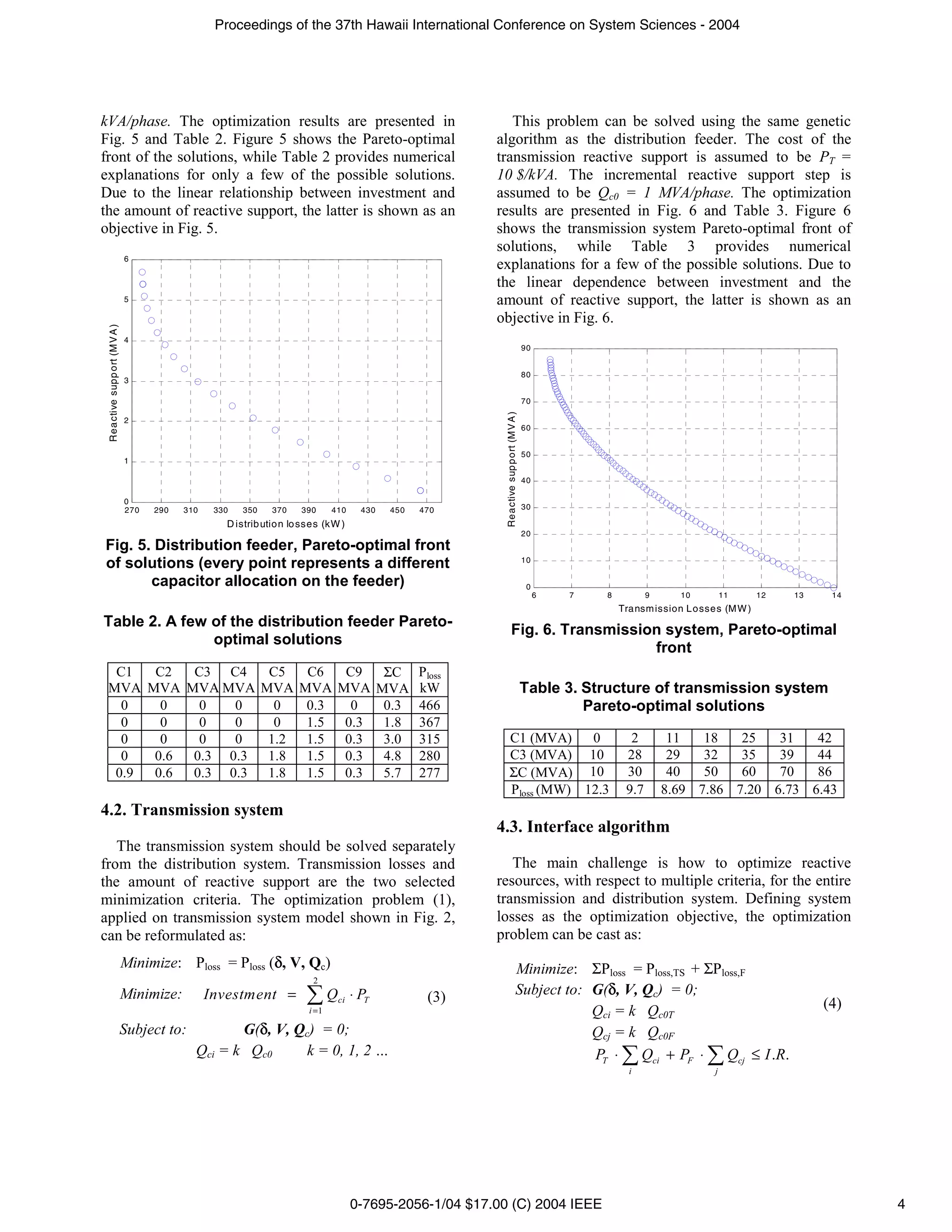This document proposes a methodology for simultaneous optimization of reactive power resources in both transmission and distribution systems. It addresses issues such as decomposing the transmission and distribution models, designing an interface for joint optimization, and using multi-objective optimization with genetic algorithms. The methodology is demonstrated on sample transmission and distribution test systems. Pareto fronts showing tradeoffs between objectives like losses and investment costs are obtained for each system individually. An interface algorithm is then needed to optimize reactive resources across both systems together considering multiple objectives.


![Proceedings of the 37th Hawaii International Conference on System Sciences - 2004
TS Optimize: F
0
Subject to: G( , V, Qc) = 0 (1)
Qci = k Qc0 k = 0, 1, 2 …
where:
4 3 1 2 F - vector of objectives
G - set of power flow equations
- vector of voltage angles
V - vector of voltage magnitudes
10 8 5 6 Qc- vector of reactive support
Qci - reactive support applied to the bus “i”
Qc0 - incremental reactive support step
4.1. Distribution system
9 7
Fig. 3. Distribution feeder model This section presents Pareto-optimal solutions for the
feeder shown in Fig. 3. Solving for any Pareto-optimal
Table 1. Feeder load data front assumes more than one objective. Two
(confronted) objectives chosen here are: 1) the
Node P (kW) Q (kVAr) investment in reactive resources (assumed to be directly
2 400 290 proportional to the amount of reactive support); and 2)
3 170 125 feeder losses. The optimization problem (1) therefore
4 230 132 can then be reformulated as:
5 1155 660
6 1013 613 Minimize: Ploss = Ploss ( , V, Qc)
9 126 86 11
10 170 80 Minimize: Investment = Qci ⋅ PF
i =1 (2)
To link the distribution feeder models with the Subject to: G( , V, Qc) = 0;
transmission network, all of the feeder loads are doubled Qci = k Qc0 k = 0, 1, 2 …
and it is assumed that ten identical feeders are connected where:
to each transmission load bus (bus 1 and bus 3). The set PF - price of capacitor on the distribution feeder
of feeders on each transmission bus represents a model
of the distribution system. 4.1.1. Genetic algorithm as an optimization tool.
There are several ways to solve the optimization
4. Optimization algorithm problem (2). Genetic algorithms (GAs) are the natural
tool for solving the problem, even more so when other
The general approach for solution of the multi- objectives are also included in the optimization. As
objective Volt-Var problem requires that reactive described in [1], “Genetic algorithms are based on the
resources be divided between the transmission and mechanics of natural selection and natural genetics”. GA
distribution system. The list of optimization objectives differs from traditional (calculus-based) optimization
may include distribution losses, distribution feeder and search procedures in following ways:
power factor, voltage profile, transmission losses, • It uses probabilistic transition rules rather than the
transmission capacity, voltage stability, etc. deterministic ones.
We propose that the power system model be separated • It does not need the knowledge of gradients or any
into transmission and distribution subsystems. These other auxiliary knowledge of the objective function.
systems are to be solved separately. Families of It uses only the objective function values, evaluated
solutions for capacitor placement are found for each at a number of points.
subsystem. These solutions should then be combined • It works with a population of solutions rather than
with a suitably designed interface algorithm to filter the with a single solution.
unique Pareto-optimal solution front. The optimization For the solution of the problem defined in (2), bi-
problem for both systems, treated separately, can be objective GA is applied. The cost of the feeder reactive
formulated as: support is assumed to be Pf = 15 $/kVA. The incremental
reactive support step is assumed to be Qc0 = 100
0-7695-2056-1/04 $17.00 (C) 2004 IEEE 3](https://image.slidesharecdn.com/10-1-1-125-7599-130305172811-phpapp02/75/10-1-1-125-7599-3-2048.jpg)


![Proceedings of the 37th Hawaii International Conference on System Sciences - 2004
Optimal feeder schedule: BUS1 - 50%, BUS3 - 50% initial solution (86MVA support
1.1 to transmission system)
no reactive support
The transmission system was supported with 14MVA, 1 solution that minimizes loses
while the overall feeder support was 48MVA (ten
0.9
feeders compensated with 4.8MVA each). The fact that
V oltage at bus 3 (p.u.)
the distribution feeders require 77% of the overall 0.8
reactive support is because of their high load and
0.7
extremely bad power factor. The best solution yields an
overall loss ΣPloss= 4.29MVA, which is 12% less than 0.6
the initial solution (16.21MVA), and still requires the
0.5
same investment. (14MVA*$10/kVA +
10feeders*4.8MVA*$15/kVA = $860,000) 0.4
0.3
5. Impact on voltage stability margin
0.2
1 1.1 1.2 1.3 1.4 1.5
The influence of the capacitor allocations discussed in Loading factor (p.u.)
the above example on the voltage stability margin is Fig. 8. System’s PV curves for different
investigated. Continuation power flow, applied on the capacitor scenarios
system model without reactive support, yields some
alarming data. The critical loading factor of the system Decomposition of the transmission model from the
is λ = 1.108 (10.8 percent load increase before voltage distribution feeders is proposed as a necessary step to
collapse). Applying reactive support to the system is reduce the complexity of the problem. After the
expected to be beneficial, but it is not known whether decoupled parts of the system are solved independently,
the transfer of reactive support from the transmission to a suitable interface is designed for simultaneous
the distribution portion of the system would worsen the optimization. Custom designed genetic algorithms are
voltage stability loading margin. The answer appears to used as multiobjective optimization tools that rely on
be negative. Transferring reactive support to the sensitivity analysis to reduce the search space and allow
distribution network decreases the reactive load of the implementation for large system models.
transmission system and increases the system voltage
stability loading margin. Figure 8 illustrates this 7. Acknowledgment
observation. The following PV curves are shown in
Fig.8: Financial support of the National Electric Energy
• No reactive support to system (λ = 1.108) Testing, Research and Applications Center (NEETRAC)
• Entire ($860k) reactive support applied to the used for part of the work presented in this paper is
transmission network (critical loading margin gratefully acknowledged. The authors also would like to
increased to λ=1.294) acknowledge Dr. Damir Novosel, with whom they had
• Minimal loss scenario (critical loading margin many fruitful discussions about multi-objective
further increased to λ=1.508) optimizations.
6. Conclusions 8. References
The problem of simultaneous optimization of reactive [1] D Goldberg, Genetic Algorithm in Search, Optimization
resources on the transmission and distribution system is and Machine Learning, New York: Addison Wesley,
solved by decoupling the analysis of the transmission 1989.
and distribution networks. The investment resources are [2] B. Baran, J. Vallejos, R. Ramos, U. Fernandez "Reactive
assumed to be limited and known. Under this Power Compensation using a Multi-objective
constraint, a number of optimization objectives can be Evolutionary Algorithm" IEEE Porto Power Tech
chosen (distribution losses, distribution feeder power Conference, Porto, Portugal September, 2001
[3] J.T. Ma, L.L. Lai “Evolutionary Programming Approach
factor, voltage profile for conservative voltage
to Reactive Power Planning” IEE Proceedings –
reduction, transmission losses, transmission capacity, Generation, Transmission and Distribution, Vol 143, No.
voltage stability, etc.). This paper addresses the various 4, July 1996
issues that need to be resolved to solve this problem.
0-7695-2056-1/04 $17.00 (C) 2004 IEEE 6](https://image.slidesharecdn.com/10-1-1-125-7599-130305172811-phpapp02/75/10-1-1-125-7599-6-2048.jpg)